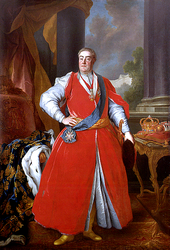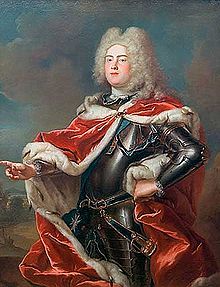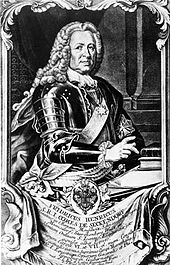War of the Polish Succession

The War of the Polish Succession (1733–1738), incorrectly called the War of the Polish Succession , broke out after the death of King August II the Strong for the succession to the throne of Poland . When choosing a successor, France actively intervened in the uprising of the magnate Stanisław Leszczyński , thereby causing a war with the Holy Roman Empire under Emperor Charles VI. The military conflicts were fought in Poland, on the Rhine and in Italy. The war ended in 1735 and the Saxon August III. confirmed as King of Poland. Leszczyński was given to the Duchy of Lorraine for the loss of the Polish crowncompensated. Due to the succession regulations, the peace could only be signed on November 18, 1738.
background
The Polish-Saxon ruler August II the Strong needed not only recognition from abroad for the stability of the existing personal union between Electorate Saxony and Poland, but also the support of the majority of Polish magnates. In Poland two aristocratic factions faced each other. One was grouped around the Potocki family , who represented the traditional forces who defended the privileges of the nobility and rejected the Wettins . In the other, the Czartoryski family dominated . This sought a modernization based on the English parliamentarism . There were signs of a victory for the reformers. When August II died in Warsaw on February 1, 1733, this positive development no longer came to fruition, and the succession to the throne of his son Friedrich August II was not secured.
While Austria and Russia, after some hesitation, supported the throne aspirations of the Saxon Elector Friedrich August II, which meant the continuation of the personal union of Saxony-Poland , France wanted to reinstate the former Polish King Stanislaus Leszczyński (the father-in-law of Louis XV ) as king. In a secret treaty dated July 16, 1733 in Vienna, the emperor had promised his support to Elector Friedrich August II and received from Saxony the recognition of the pragmatic sanction .
The conflict that broke out was not only about the succession in Poland, but primarily about the power struggle between France and the Catholic Habsburgs. Because of the upcoming marriage of Archduchess Maria Theresa with Franz Stephan von Lothringen, France feared a further strengthening of Austrian power. The Habsburgs' influence in Lorraine was unacceptable for the security of France. France therefore declared on October 10, 1733 the Emperor Charles VI. and Russia under Empress Anna the war. In addition to France, Spain and Savoy also declared war on the emperor, their common goal being to gain their own territories at the expense of the Italian territory of the Habsburgs .
Stanislaus Leszczyński returned to Poland from his French exile. A large confederation of Polish nobles under the leadership of the Cardinal Primate Teodor Potocki elected Leszczyński as the new king on September 10, 1733. However, it was not recognized by the powers Austria, Russia and Electoral Saxony, as well as part of the Polish nobility. Russia agreed to the regulation of the throne in favor of August after the latter agreed to the renunciation of Livonia and the guarantee of the independence of the Duchy of Courland . The partisans of the emperor and Russia immediately set the election of August III as a reaction . and his coronation on January 17, 1734, Stanislaus was ousted and forced to flee to Danzig .
The main theaters of war
Clashes in Poland
At the end of September 1733, Russian troops appeared before Warsaw , under whose protection the much smaller Saxon party succeeded in electing Friedrich August. In particular, numerous Lithuanian aristocrats voted for Saxony. It was not the party of his aristocratic voters who rose up for the Leszczyńskis cause, but rather the mostly German citizens of the powerful port city of Danzig. Stanislaus Leszczynski fled to Danzig , which was then besieged by Russian and Saxon troops under General Peter von Lascy and only capitulated on June 30, 1734. A French expeditionary force that landed in support of Leszczynski was shot down by the superior Russians under General von Münnich . Stanislaus escaped disguised as a farmer to Königsberg , where the Prussian King Friedrich Wilhelm I refused his extradition demanded by the Russians.
After the surrender of Danzig was formed in November 1734 under Adam Tarlo the Confederation of Dzików to protest against the Saxon troops in Lesser Poland to fight. The Confederation had no chance from the outset, but did not end the fighting until March 1736 (two months after Leszczynski's abdication). Incidentally, within the framework of the alliance, Russian troops were once again stationed in Lithuania and eastern Poland, as Saxony wanted to have its troops near the border due to Prussia's uncertain position.
Theater of war on the Rhine
The acts of war took place mainly on the Rhine border , initially under the command of the 71-year-old Prince Eugene of Savoy , who is said to have made the Prussian Crown Prince Friedrich more familiar with the art of war there. The French built two bridges over the Rhine, one near Germersheim , a second near Oberhausen . On October 12, 1733, French troops crossed the Rhine near Kehl and attacked the fortress with 15,000 men from the 19th, which was defended by 1306 district troops and 106 Austrian infantry under the Württemberg field marshal lieutenant Ludwig Dietrich von Pfuhl and on October 29th capitulated. During the winter the imperial troops gathered near Heilbronn , but this army was outnumbered by the 70,000 French soldiers. Baron Gottfried Ernst von Wuttgenau was given command of the Philippsburg Fortress by Prince Eugen in December 1733 .
In the spring of 1734, the Duke of Berwick moved up the Rhine Valley with a strong army to wrest the Philippsburg fortress from the imperial family. On June 1, 1734 the siege of the fortress began , which was surrounded by 60,000 men. The approximately 35,000-strong Imperial Relief Army under Prince Eugene did not succeed in breaking the siege ring. On June 12, the Duke of Berwick was killed by a cannonball while inspecting a trench. Claude François Bidal d'Asfeld was appointed Maréchal de France and was given supreme command of the Rhine Army. On June 22nd, he attacked a covered path of the fortress, which brought in 60 prisoners and led to the removal of a bastion. A month later, on July 18th, the fortress surrendered and the garrison received an honorable withdrawal to Mainz. The imperial commander of the fortress, Baron von Wuttgenau, was promoted to field marshal lieutenant for the long defense against superior forces . Count Friedrich Heinrich von Seckendorff , who led the army command for some time, distinguished himself as the commander of the imperial army, which was retreating from Philippsburg towards Bruchsal .
In October 1734, Prince Eugene handed over the supreme command on the Rhine to Karl Alexander von Württemberg , he had provided the fortresses of Freiburg, Breisach and Mainz, which were still under imperial command, with sufficient troops and supplies for a siege. General von Seckendorff organized the establishment of a defensive position along the Rhine between Koblenz and Mainz and became governor of the latter fortress.
Emperor Charles VI. did not accept an offer from King Friedrich Wilhelm I to strengthen the imperial army on the Rhine with 50,000 men because he did not want to make a concession to the Prussians in the Jülich-Berg succession. Instead, in the summer of 1735, the Kaiser approved the march of Russian troops through German territory to reinforce the threatened Neckar front. In the summer of 1735, Prince Eugene went to the front again at the emperor's request, his headquarters were in Heidelberg . The first regiments of the Russians under General von Lacy arrived there at the end of August. General of the cavalry Seckendorff advanced with 30,000 men over the Hunsrück and on October 20 repulsed French troops near Salmbach and in the battle near Klausen . His troops kept the French in check in the Eifel region and on the Rhine until the armistice was concluded on November 11, 1735.
Theater of war Italy

France provided an army of 40,000 soldiers for the Italian theater of war to fight the Austrians, which had ruled the Viceroyalty of Naples and the Duchy of Milan since the end of the War of the Spanish Succession . Charles Emanuel III. von Savoyen agreed on September 26, 1733 in Turin with the French and Spaniards a joint approach in Italy. The Kingdom of Sardinia-Piedmont provided 24,000 soldiers. For its entry into the war, Bourbon Spain was to receive Tuscany and the Kingdom of Naples, which had been lost after the War of the Spanish Succession.
The French-Sardinian armed forces under the old Maréchal de Villars marched into Lombardy and seized all Austrian bases in northern Italy, as these were only very weakly occupied with troops. The inferior imperial troops, which western Lombardy could not hold, left the garrisons and withdrew with the majority to Mantua . Villars arrived at the Pizzighettone warehouse on November 11th and took that place twelve days after the trenches were opened. His sinking strength and his dissatisfaction with his comrade-in-arms, the Duke of Sardinia, moved him to request his recall. On December 11, 1733, the Piedmontese entered Milan under their king and besieged the city's castle. The Austrian governor of Milan, General Wirich Graf Daun , had 12,000 soldiers and did not want to surrender without a fight. The castle of Milan fell into the hands of the besiegers on December 29th. Only the strong fortress of Mantua remained for the imperial family. The last to fall on February 3, 1734, was the Castell de Tortona , while most of the troops were already in their winter quarters.
At the beginning of spring 1734, military operations shifted to the southern bank of the Po . The Austrians reinforced the army in Italy to 60,000 soldiers with the aim of starting the counter-offensive in the direction of Parma. The Franco-Savoy troops under Charles Emmanuel III. tried to claim the territory in favor of the Spanish king, who was also Duke of Parma and Piacenza . The French army, now commanded by Marshals François-Marie de Broglie and the Duke of Coigny , faced the imperial troops under Count Claudius Florimund Mercy and Prince of Württemberg-Winnental . While the French leadership could be well coordinated, the two imperial leaders harbored an aversion to one another.
Between May 1 and May 2, 1734 the Austrians crossed the Po with the main contingent of their troops on two temporary bridges at Portole and San Benedetto . The French troops, distributed along the river to prevent this crossing, were taken by surprise and withdrew in disarray. The Austrians were therefore able to occupy the area up to the Enza river without resistance. The French-Sardinian cavalry had cordoned off the area south of the Po near Sacca and rejected the Austrian vanguard under General Hohenems near Colorno . The Austrians then had to turn south, and Count von Mercy suffered a stroke. The supreme command therefore fell at short notice to the Prince of Württemberg, who lost the battle of Parma on June 29 and had to return to Veneto. The victorious allies advanced to the Secchia and occupied Guastalla and Modena. On July 20, the Duke of Modena , Rinaldo d'Este , fled with his court to Bologna .
At the beginning of September 1734, the Austrians under Count Königsegg near Gardella managed to evacuate the camp on September 15 and march towards Quistello. An attack between the Secchia and Bondanello surprised the Franco-Sardinian army in the battle of Quistello , they succeeded in routing the enemy and conquering the entire camp. Field Marshal Königsegg was forced to strike because of his own supply problems, attacked the superior enemy again on September 19, 1734 and lost the decisive battle at Guastalla . The Austrians lost 7,000 men, including the Prince of Württemberg-Winnental. After the French-Piedmontese army under Marshal Broglio had not exploited their victory, the Austrian units at Luzzara were able to stabilize their situation and prevent a further advance on Mantua.
In 1733 Count Caraffa had criminally neglected the defense of the viceroyalty of Naples in southern Italy . In mid-May 1734 he had to hand over the supreme command to the senior general, Prince Pignatelli . In the meantime a Spanish elite corps with 11,000 men and 5,600 horsemen had landed in Calabria . On May 22nd, Pignatelli went to the Viceroy Count Visconti to coordinate further military action. The Spanish commander, Duke of Montemar , defeated the Austrians on May 26 at the Battle of Bitonto . The fortress of Bari also surrendered to the siege army under Montemar on May 26th, and 4,000 men with all their war equipment went to the Spaniards. The Spaniards gained control of the province of Apulia . The Infante Don Carlos was proclaimed King of Naples and at the end of August 1734 his troops under Montemar landed on Sicily . The capital Palermo opened its gates quickly, and only the citadel of Messina , defended by FML Prince Lobkowitz , as well as Trapani and Syracuse withstood a little longer. The Austrian garrison under FML Traun in Capua lasted the longest on the mainland ; it only surrendered on November 30, 1734 against free withdrawal and was transported on Spanish ships to Trieste . The Kingdom of Naples was lost to Habsburg.
After the withdrawal of the main Austrian army via Mantua, Mirandola had to be handed over to the French on September 2, 1735, and in mid-September the imperial troops camped in a defensive position near Schio. France, under the leadership of its first minister ( Cardinal Fleury ), had the economic and military preponderance in this war, but wanted to save its funds for the War of the Austrian Succession, which had been emerging since the Pragmatic Sanction in 1713 .
Peace and Consequences

In the Vienna Preliminary Peace of 1735 the Saxon was named August III. confirmed as King of Poland. Stanislaus Leszczynski was by Louis XV. compensated with the duchies of Bar and Lorraine , where he became very popular as the father of the country. Franz Stephan von Lothringen, who was already emerging as the emperor's son-in-law and now finally had to give up his ancestral duchy, was resigned to the Grand Duchy of Tuscany , as the extinction of the main Medici line was already foreseeable at this point in time. The Kingdom of Naples and the Kingdom of Sicily fell to the Infante Don Carlos. Spain renounced the Duchy of Parma and Piacenza and its claim to Tuscany in favor of Austria . Due to the succession arrangements, the peace could only come into force after the death of Duke Gian Gastone de 'Medici († 1737). The war ended with the proclamation of the Peace of Vienna on November 18, 1738.
The war indicated some innovations that had a stronger influence on Europe's political power structure in the following years. On the one hand, the young Prussia offered the Roman-German emperor for the first time its entire army, which was highly modern for the time, to defend the empire, but the emperor refused. On the other hand, the emperor first accepted Russian troops on the Rhine (1735).
Emperor Charles VI. hoped to compensate for the heavy loss of territory in Italy in a new war against the Turks . The emperor's justification for entering the war was an alliance entered into with Russia in 1726, which obliged him to support at least 30,000 soldiers in the event of war. The armed conflict between France and the House of Austria continued after the death of Emperor Charles VI. (1740) in the War of the Austrian Succession .
Grenadier Prussian regiment on foot Roeder in the War of the Polish Succession in 1734
Imperial Károlyi Hussar - one of the early hussar regiments in 1734
Grenadier of the Paderborn Regiment of the Lower Rhine-Westphalian District
French Grenadiers of the Royal Guard of Louis XV.
Web links
literature
- John L. Sutton: The King's honor & the King's Cardinal: the war of the Polish succession. University Press of Kentucky, Lexington 1980.
Individual evidence
- ↑ Poland was an elective monarchy! ( PLOETZ Lexicon of World History. Licensed edition for Wiss. Buchgesellsch. Darmstadt 2000, p. 371.)
- ↑ Manfred Alexander : Small history of Poland (= Federal Center for Political Education. Series of publications. 537). License issue. Federal Agency for Political Education, Bonn 2005, ISBN 3-89331-662-0 , p. 151 f.
- ↑ Manfred Alexander: Small history of Poland (= Federal Center for Political Education. Series of publications. 537). License issue. Federal Agency for Political Education, Bonn 2005, ISBN 3-89331-662-0 , p. 152.
- ↑ Gottfried Mraz : Prinz Eugen. A life in pictures and documents. Süddeutscher Verlag, Munich 1985, ISBN 3-7991-6224-6 , p. 186.
- ↑ Hans Bleckwenn: Horsemen, Hussars and Grenadiers. The uniforms of the Imperial Army on the Rhine 1734. 2nd edition. 1985, p. 12.












